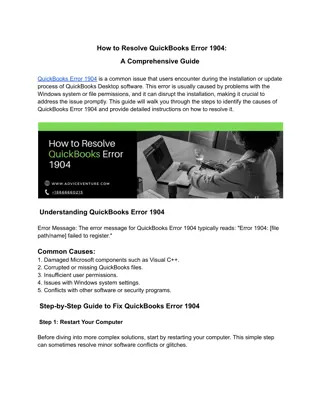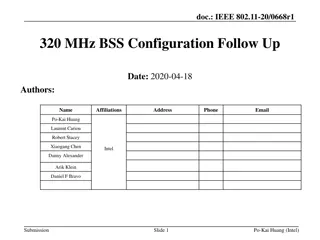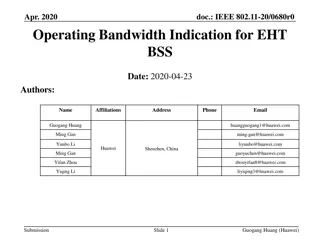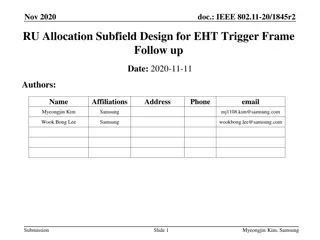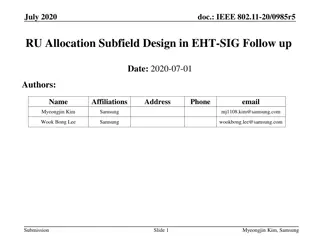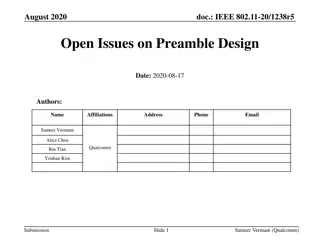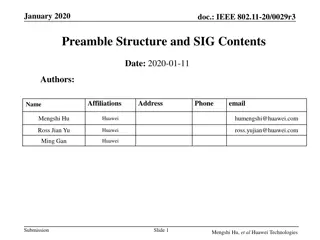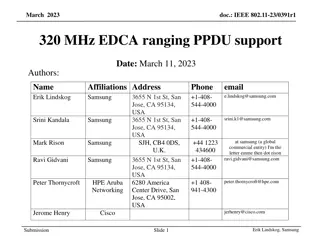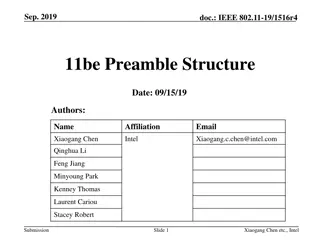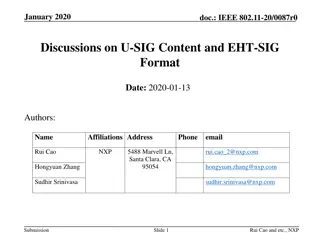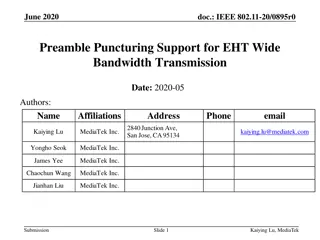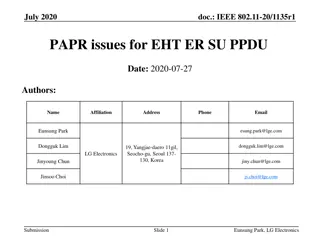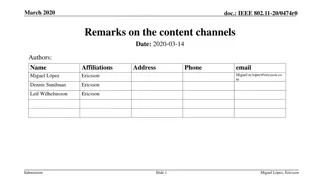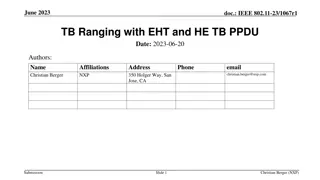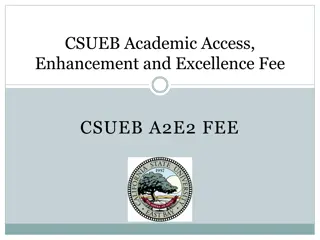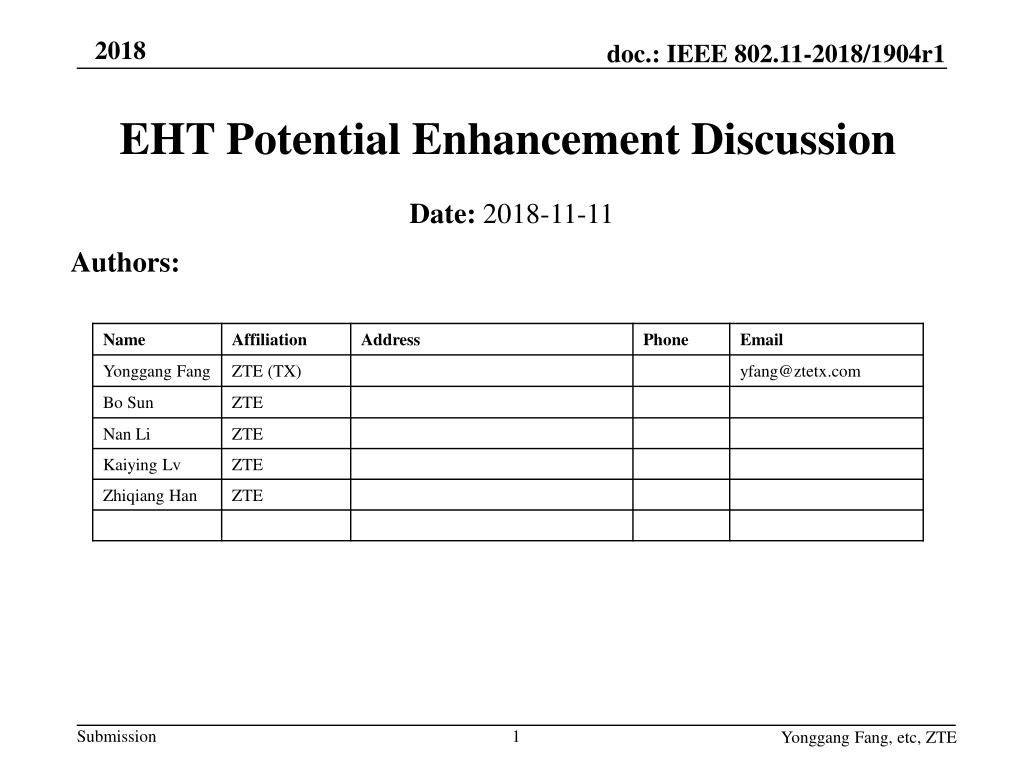
IEEE 802.11-2018 EHT Potential Enhancements Discussion
Explore potential enhancements for IEEE 802.11-2018 EHT including operation bands, backward compatibility, channel discovery, and transmission reliability. Consider regulatory implications and multi-band coordination in wireless communication systems.
Download Presentation

Please find below an Image/Link to download the presentation.
The content on the website is provided AS IS for your information and personal use only. It may not be sold, licensed, or shared on other websites without obtaining consent from the author. Download presentation by click this link. If you encounter any issues during the download, it is possible that the publisher has removed the file from their server.
E N D
Presentation Transcript
2018 doc.: IEEE 802.11-2018/1904r1 EHT Potential Enhancement Discussion Date: 2018-11-11 Authors: Name Affiliation Address Phone Email Yonggang Fang ZTE (TX) yfang@ztetx.com Bo Sun ZTE Nan Li ZTE Kaiying Lv ZTE Zhiqiang Han ZTE Submission 1 Yonggang Fang, etc, ZTE
2018 doc.: IEEE 802.11-2018/1904r1 Abstract This contribution provides our views on 802.11 EHT and discusses some potential enhancements. Submission 2 Yonggang Fang, etc, ZTE
2018 doc.: IEEE 802.11-2018/1904r1 Potential Operation Bands Legacy license-exempt bands EHT STA can operate on 2.4 GHz and 5GHz New operation band EHT may extend the operation on 6 7.125 GHz This band is a shared access spectrum with fixed wireless and satellite communication services. 3GPP is also studying on NR-U over sub-7 GHz bands. EHT may need to consider sharing and co-existing with NR-U. Regulatory is working on how to use this band efficiently FCC is seeking for the input via NPRM [1] EU ETSI is also investigating the wireless access systems including WAS/RLANs in the 6GHz band [2], [3] Submission 3 Yonggang Fang, etc, ZTE
2018 doc.: IEEE 802.11-2018/1904r1 Objectives Backward Compatibility EHT stations should be allowed to operate in multi-bands. When an EHT station operates on 2.4GHz and/or 5GHz, the backward compatibility to legacy stations should be considered. As 802.11ax is also working on operation on 6GHz band, EHT should consider the backward compatibility to 802.11ax stations as well. Potential EHT Enhancement Areas Channel discovery in Multi-Band Coordinated Multi-AP on Multi-Band Operation Access efficiency improvement Transmission reliability improvement Timing synchronization Throughput improvement Submission 4 Yonggang Fang, etc, ZTE
2018 doc.: IEEE 802.11-2018/1904r1 Channel Discovery Potential Enhancement in Multi-Band with 6 GHz (1) The shared access spectrum requires lower priority users to occupy the channel only when the higher priority users are not using the channel, or operate in particular locations. FCC [1] indicates that In the 5.925-6.425 GHz and 6.525-6.875 GHz sub-bands, unlicensed devices would only be allowed to transmit under the control of an automated frequency control (AFC) system. In the 6.425-6.525 GHz and 6.875-7.125 GHz sub-bands, unlicensed devices would be restricted to indoor use and would operate at lower power, without an AFC system Therefore, it may require a dynamic or semi-dynamic spectrum management to control EHT stations to share the spectrum with primary users. Submission 5 Yonggang Fang, etc, ZTE
2018 doc.: IEEE 802.11-2018/1904r1 Channel Discovery Potential Enhancement in Multi-Band with 6 GHz (2) In IEEE 802.11ad, a multi-band enabled AP uses one or more Multi-Band elements to inform bands/channels supported by the current multi-band device. For each Multi-band element , starting from the first one and proceeding in increasing order, the STA should attempt to join the BSS using the BSSID indicated by the BSSID field, frequency band indicated by the Band ID field and channel number indicated by the Channel Number field . There is no restriction of the band selection that 802.11ad multi-band device should start an initial network scan. Submission 6 Yonggang Fang, etc, ZTE
2018 doc.: IEEE 802.11-2018/1904r1 Channel Discovery Potential Enhancement in Multi-Band with 6 GHz (3) TGax PAR already supports 6 GHz band. However, it has not decided the network discovery and scan procedure on 6 GHz band. [9] proposes a procedure about network discovery on the 6 GHz band: STAs send Probe Req to 5/2.4 GHz AP o Active scanning is concentrated in 2.4 and/or 5 GHz bands 5/2.4 GHz AP sends Probe Resp containing the information related to 6 GHz discovery/operation o E.g., channel number, BSSID, EDCA intervals of the target co- located 6 GHz AP STA sends management frame in the 6 GHz channel only during the allowed time window o E.g., STA sends unicast Probe Req to that AP using EDCA access or in response to a Trigger frame for random access Submission 7 Yonggang Fang, etc, ZTE
2018 doc.: IEEE 802.11-2018/1904r1 Channel Discovery Potential Enhancement for Multi-Band with 6 GHz (4) A similar approach was discussed for EHT as well. This controlled channel scan and network discovery in 6GHz may help to reduce power consumption of STAs and network overhead. APs or coordinated Multi-APs operating in multi-band may use a similar way to broadcast the Multi-Band information for 6 GHz. This information can be included in a beacon or other frames. This information can minimize the number of channels in passive scans and speed up the network discovery process. In addition, this information can be used to assist a STA to schedule transmissions in advance on those channels in 6 GHz band with guaranteed access resource. Submission 8 Yonggang Fang, etc, ZTE
2018 doc.: IEEE 802.11-2018/1904r1 Channel Discovery Potential Enhancement in Multi-Band with 6 GHz (5) We suggest that EHT may provide some guidance for the channel scan and network discovery procedure in multi-band operation. Initial channel access on 2.4/5/6 GHz band should be allowed. For a STA starting network scan on 2.4GHz/5GHz, the AP may need to provide the Multi-Band information with TB RA starting time in 6 GHz band to guide STAs to initiate a network scan in 6 GHz band. The Multi-Band information may include the available channels in 6 GHz band. APs operating in 6 GHz band transmits short beacons on those channels, with the information of APs' identifiers, primary channels, etc. for EHT stations to perform passive scans. Submission 9 Yonggang Fang, etc, ZTE
2018 doc.: IEEE 802.11-2018/1904r1 Multi-AP Coordination Channel Access Random Access in 6 GHz EDCA Designed for the single channel access, may not be efficient for access to multi-channel in multi-band operated by multi-AP. Higher collision in the contention and longer channel waste time, especially in the dense deployment. Longer latency of access to a channel, not suitable for timing sensitive transmissions, especially for real time applications. TB Random Access May be used in 6 GHz band operation. As the RA relies on the trigger frame sent by an AP, TB RA may delay the STA to access to a channel if a TB RA frame is not transmitted very often, or TB RA may take too much air time, if it is sent too often. Submission 10 Yonggang Fang, etc, ZTE
2018 doc.: IEEE 802.11-2018/1904r1 Multi-AP Coordination Channel Access Potential Enhancement of Random Access in 6 GHz TB RA in Multi-AP in 6 GHz EHT may need to provide a guidance on how to transmit the TB RA to reduce the access delay, as the delay of access to the medium depends on how frequent the TB RA is transmitted. EHT may need to investigate and enhance how the TB RA mechanism for STAs to access to the coordinated multi-AP more efficiently. TB RA in Multi-Band EHT may also need to enhance TB RA for STAs to access to the multi channels on multi-bands. Submission 11 Yonggang Fang, etc, ZTE
2018 doc.: IEEE 802.11-2018/1904r1 Multi-AP Coordination - Reliability Reliability a known issue of WiFi, especially for timing sensitive applications Multi-AP on Multi-Channel operation Case 1: AP1 and AP2 operates in different channels, in same or different band. STA with dual radio independently operates on each channel. Case 2: AP1 and AP2 operates in the same channel. STA with a single radio operates in the same channel. GW AP2 AP1 STA Submission 12 Yonggang Fang, etc, ZTE
2018 doc.: IEEE 802.11-2018/1904r1 Multi-AP Coordination - Reliability Potential Reliability Enhancement with M-AP in M-CH EHT may leverage the duplicated (joint or coordinated) transmissions over multi-channels from coordinated multi-AP to improve the transmission reliability. MAC enhancement in case 1: AP1 and AP2 may operate independently, and transmit the same MSDU on different channels. The STA may perform MAC layer selection for the best MSDU among the received transmissions sent by AP1 and AP2. PHY/MAC enhancement for case 2: AP1 and AP2 need the timing synchronization Based on the receiving condition, the STA points to the best AP. Either AP1 or AP2 transmit a PPDU according to the STA selection. Or Both AP1 and AP2 may transmit the same PPDU on the same channel. The STA can performs the maximum ratio combining on the received PPDUs. Submission 13 Yonggang Fang, etc, ZTE
2018 doc.: IEEE 802.11-2018/1904r1 Multi-AP Coordination Timing Sync Timing Synchronization The current 802.11 specification is an asynchronous transmission protocol. In distributed multi-AP, EHT may need to consider whether or not it is necessary to use the synchronized transmission among distributed multi-AP: Pros: In the synchronized transmission protocol, multiple transmissions from different APs would be easy to align up and reduce the interference among the transmissions. Cons: It is not flexible for transmissions from un-managed APs. Submission 14 Yonggang Fang, etc, ZTE
2018 doc.: IEEE 802.11-2018/1904r1 Multi-AP Coordination Timing Sync Potential Enhancement for Timing Synchronization GPS based timing synchronization In distributed multi-AP, GPS signals may not be always available especially in the indoor scenario. Therefore multi EHT APs might not rely on the GPS for timing synchronization. NTP based timing synchronization In the multi-AP, all the managed APs may be synchronized via IEEE1588 and/or NTP over wired networks, or in other ways. EHT may need to further study whether the resolution of timing synchronization can meet the requirement. Timing synchronization with STA EHT may use a beacon frame to carry the synchronized timing information to stations in the Multi-AP coverage area. A STA may use IEEE802.11 FTM for the timing adjustment, if needed. Submission 15 Yonggang Fang, etc, ZTE
2018 doc.: IEEE 802.11-2018/1904r1 Multi-AP Coordination - Throughput Potential Throughput Improvement with Multi-AP Coordinated Multi-AP MU-MIMO or MU-BF [6] summarizes proposals of improving transmission efficiency via coordinating multi-AP in MU-MINO and MU-BF operations. This feature will take the advantages of coordinated multi-AP to schedule MU-MIMO transmissions from distributed APs to improve the transmission throughput, specially for DL. Pointing null beams in the spatial domain to neighbor STAs via coordinating multi-AP operation would reduce the interference to those STAs so as to improve their throughput. Submission 16 Yonggang Fang, etc, ZTE
2018 doc.: IEEE 802.11-2018/1904r1 Summary EHT Considerations backward compatibility EHT Potential Enhancement Areas Channel discovery in Multi-Band operation Multi-AP coordination in Multi-Band Access efficiency improvement Reliability improvement through coordinating multi-AP in multi-band Timing synchronization in coordinated multi-AP Throughput improvement through multi-AP coordination Submission 17 Yonggang Fang, etc, ZTE
2018 doc.: IEEE 802.11-2018/1904r1 References 1. FCC NPRM FCC-CIRC 1810-01, Oct 2018 2. ETSI TR 103 524 System Reference document, Wireless Access Systems including Radio Local Area Networks (WAS/RLANs) in the band 5 925 MHz to 6 725 MHz (draft) 3. ETSI BRAN TR 103 631 Technical Report Wireless access systems including radio local area networks (WAS/RLANs) in the band 6 725 MHz to 7 125 MHz (draft) 4. Ofcom Fixed Wireless Spectrum Strategy, Feb 2018 5. IEEE802.11ad, Amendment 3 Enhancements for Very High Throughput in the 60 GHz Band, Dec. 2012 6. 11-18-1509-00-0eht-features-for-multi-ap-coordination 7. 11-18-1439-00-0eht-distributed-mu-mimo 8. 11-18-1510-01-0eht-ap-coordinated-beamforming-for-eht 9. 11-18-1256-00-00ax-11ax-6ghz-operation Submission 18 Yonggang Fang, etc, ZTE
2018 doc.: IEEE 802.11-2018/1904r1 Thank you! Submission 19 Yonggang Fang, etc, ZTE

